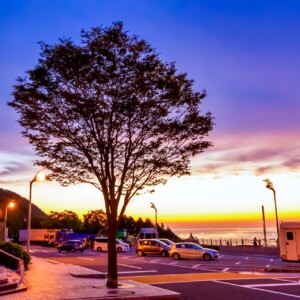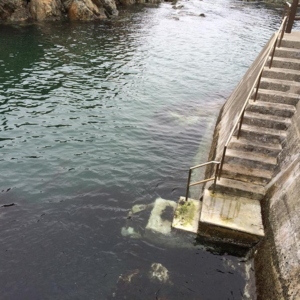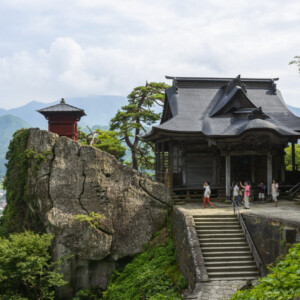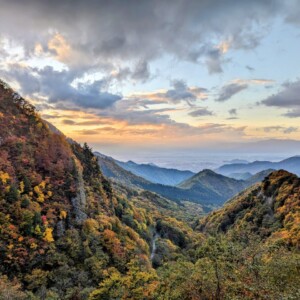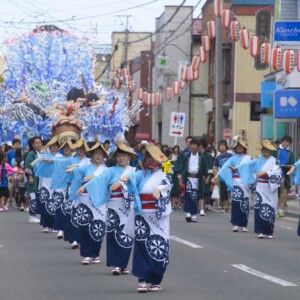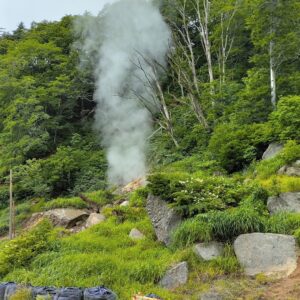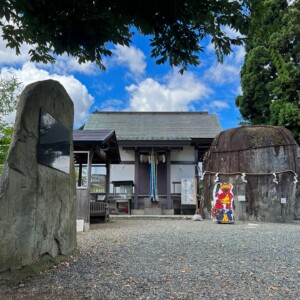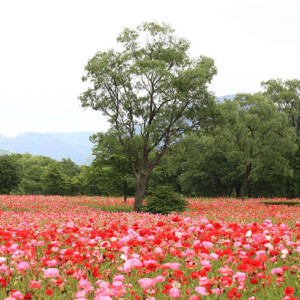
[Third] Sugae Masumi walked in Oga Peninsula - Encountered a major earthquake [Akita Prefecture]
table of contents
- 1 Walking along the southern part of Oga Peninsula from west to east
- 2 ``Camellia Shiraiwa'', which Masumi described as shaped like a mushroom
- 3 A large earthquake hits a village in the central Oga Peninsula
- 4 There were aftershocks for days after the main shock, and villages on the south coast were devastated.
- 5 In Akita Prefecture, six years before the Oga earthquake, the Kurogata earthquake caused major changes in the topography.
- 6 Experience Namahage in a village in the northern part of the Oga Peninsula in January
- 7 On the Oga Peninsula where Masumi Sugae walked, there are 90 marker posts and information boards set up to help you take a stroll.
- 8 Link: Retracing the Oga Peninsula that Masumi Sugae walked (3 times in total)
Based on the Edo period traveler Sugae Masumi (1754-1829), a traveler from the Edo period, [ Oga's Five Winds a traveler from the Oga Peninsula, he wrote about his journey through , and contrasts the Edo period with the present day .
Oga's Cold Wind the final volume of Oga's Journey, which begins on July 18, 1810 . "Oga's Cold Wind" describes in detail the feelings and the devastation surrounding the people when they encountered a major historical earthquake.
This article will be written with reference to the Akita Prefectural Museum, the National Archives of Japan manuscript, the National Diet Library manuscript, and the modern translation published in 2000. Dates in the Edo period are the dates and times recorded by Masumi (old calendar) unless otherwise noted.
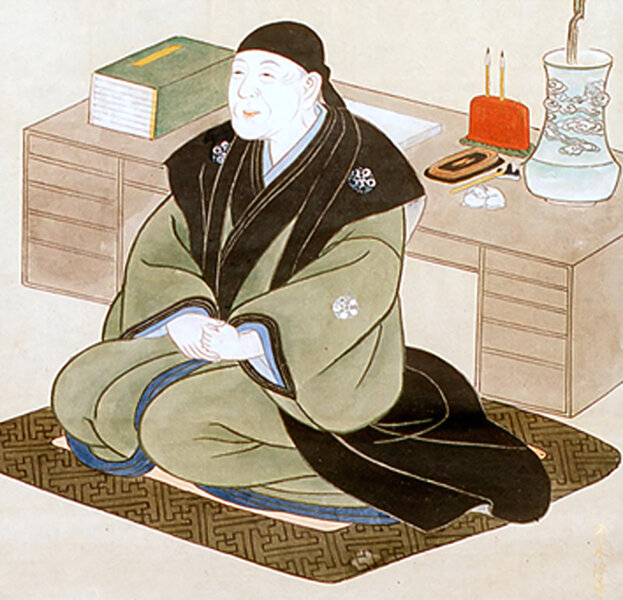
reference
- Akita Prefectural Museum Masumi Sugae Library (Manuscripts)
- URL: Akita Prefectural Museum Masumi Sugae Library
- National Diet Library Digital Collection Akita Series Special Collection No. 1 (Masumi Sugae Collection No. 1/Manuscript)
- URL: National Diet Library Digital Collection
- National Archives Masumi Travelogue (manuscript of 1898)
- URL: National Archives Masumi Travelogue
- Published by Heibonsha Masumi Sugae Travelogue 5 Edited and translated by Takeshi Uchida and Tsuneichi Miyamoto Published on August 9, 2000
Walking along the southern part of Oga Peninsula from west to east
"Oga no Kankaze" will begin on July 18th at the gate at the southwestern tip of the Oga Peninsula (Funagawa Port Motoyama Monzen, Oga City), following on from "Oga no Shimakaze" which ended on July 17, 1810.
``Camellia Shiraiwa'', which Masumi described as shaped like a mushroom
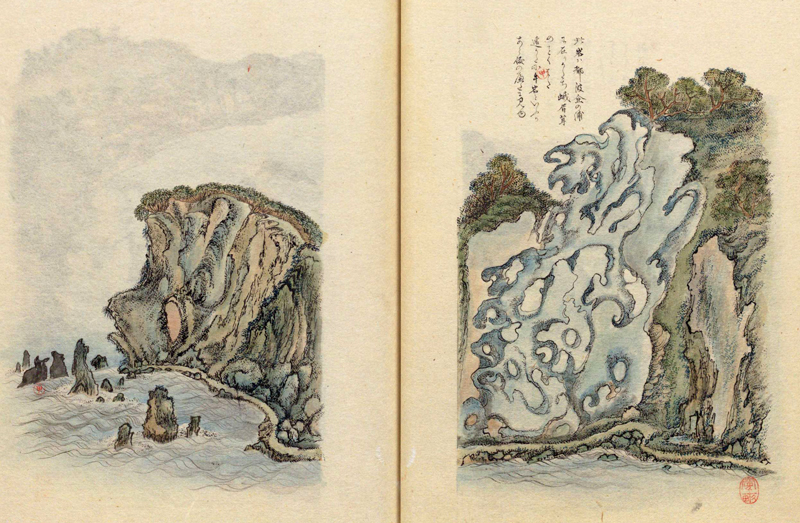
On the way from the gate Wakimoto we pass by a white-colored rock called " a tall rock of 20 Away (approximately 30m) Tsubakinoura .
The rock, which was explained by his guide, was " This is Shirasaki of Camellia wrote down this rock in Oga Autumn Wind It seemed to be raining at the time, and he wrote, "It was wet with the rain and the tide, and it looked strange, blue, but this time the weather was nice and the rocks were pure white like the name.
Today, it is called "Tsubaki no Shiraiwa," but because Masumi described it as a maitake mushroom-like shape, it is also called " Maitake Rock. "
Camellia Shiraiwa is a volcanic gravel tuff (Kazanreki Gyokaigan) that is solidified from volcanic gravel that erupted from volcanic activity about 21 million years ago, and its round shape, which was attached with a spoon, called maitake mushrooms by Masumi, was naturally created by weathering the rocks.
In addition to white, there are also many green rocks (green tough) in the area. This is also a type of volcanic gravel tuff, the same as Camellia Shiraiwa, and the substances contained in the body have been changed to green due to the influence of water heated by underground magma.
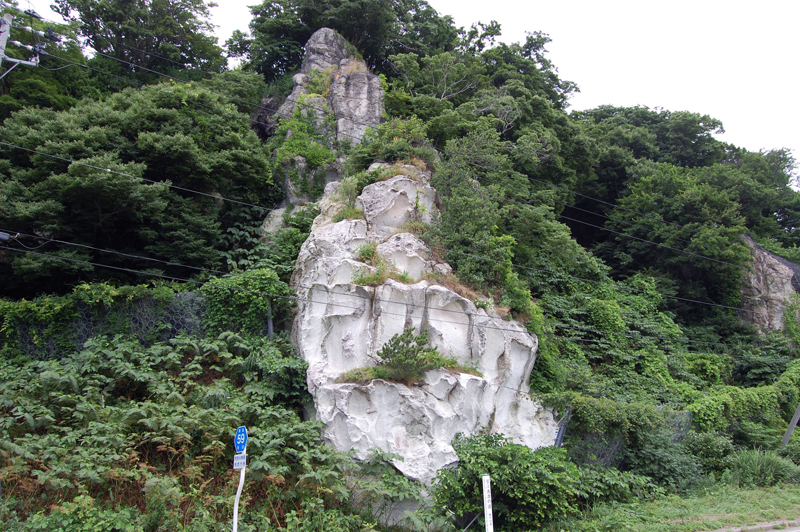
INFORMATON
- Facility name: Tsubaki no Shiraiwa
- Location: Funakawa Minato Tsubaki, Oga City, Akita Prefecture
- Phone number: 0185-24-4700 (Oga City Tourism Association)
- access:
- Public transportation: Approximately 30 minutes by bus from JR Oga Line Oga Station, get off at Tsubaki Fisheries Association bus stop
- Car: Approximately 40 minutes from Akita Expressway Showa Oga Peninsula IC
GOOGLE MAP
A large earthquake hits a village in the central Oga Peninsula
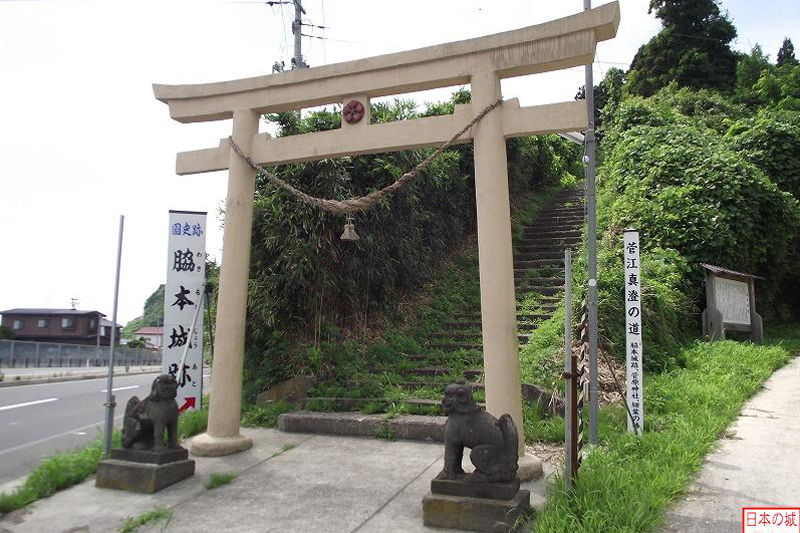
The same day, Masumi arrived at Wakimoto and headed to Oibanasaki visited the shrine (Sugawara Shrine) of Sugawara which enshrines
From Wakimoto, I will be traveling across the Oga Peninsula and spending the day at an acquaintance's house in Ayukawa
It's August 17th, and creepy and strange events continue. It's an earthquake. On the 18th, there was an earthquake that caused the temple tower to collapse.
On August 25th (Masumi says it will be September 25th, but on August 25th I made a mistake), I headed back to Wakimoto to visit Sugawara Shrine, but the weather was bad and I spent time in a village called Shimada (Oga Nakataki Kawashimada, Oga City) on the way.
The weather improved on August 27th, and just as they were about to go out, a major earthquake occurred. Masumi wrote the following about the situation at that time.
``The eaves and eaves bowed, and people ran into the open air, screaming and holding the hands of the sick and elderly... Some ran around carrying infants upside down.'' ``The beams fell down with a tremendous sound.'' I fell. As I was standing there, the mountain at the edge of the eaves collapsed, and I felt like my life was in danger, so I grabbed onto a tree and fled into a bamboo forest."
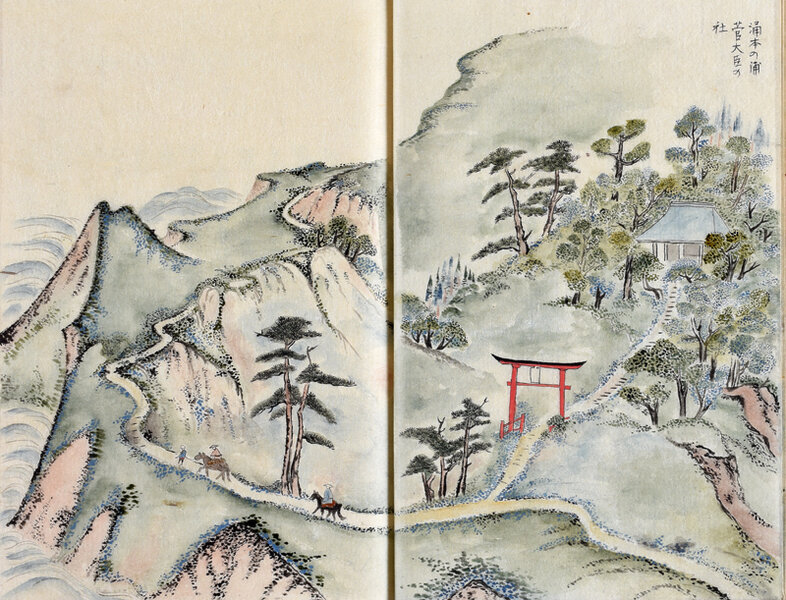
There were aftershocks for days after the main shock, and villages on the south coast were devastated.
There were many aftershocks that day, and even two days later, on the 29th, the aftershocks still continued along with the ground rumbling. In particular, the southern coast of the Oga Peninsula, including Wakimoto, where I had planned to go, was severely damaged, with no buildings remaining in any of the villages, and there were many casualties.
As Masumi wrote, this major earthquake that occurred at 2pm on August 27th, 1810 (September 25th, Solar Calendar), had been frequently seen for quite some time.
later the Oga Dai Earthquake or Ugo Earthquake , had a magnitude of 6.6, and as Masumi wrote that on the north coast of Oga Peninsula, "Kitaura has little damage," it appears to have been affected.
However, it is recorded that the number of houses in the affected area was 1,400, and the number of houses fell apart and 58 deaths. We didn't know the depth of the epicenter, but it is estimated that it was a direct earthquake. (Source: "1983 Japan Sea Chubu Earthquake: Oga City Records" by Oga City, Akita Prefecture)
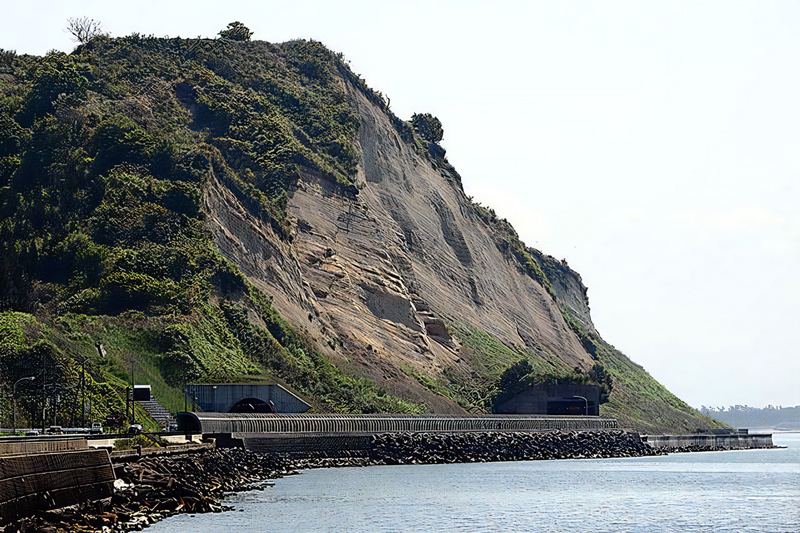
This earthquake has brought about major changes in the topography. About 700m at the tip of Ikuhanazaki, where the ruins of Wakimoto Castle and Sugawara Shrine are located, collapsed, resulting in its current form.
In Akita Prefecture, six years before the Oga earthquake, the Kurogata earthquake caused major changes in the topography.
the story of a famous spot in Dewa Province Prefecture which he visited when he was 30 years old (1784) , when he was buried 20 years later in 1804, when a major earthquake struck him.
The scenery of Ekigata Kujukushima has been said to be so beautiful that it has been called Matsushima since ancient times, and many people, including Matsuo Basho, have visited for sightseeing. In the 1804 earthquake, more than 2m of land rose, and the shallow seabed of Kujukushima Island became land overnight.
Although Masumi did not leave any illustrations of the tragic landscape after the Oga Earthquake, he visited Wakimoto, which was near the epicenter of the earthquake and suffered the most damage, and wrote about the tragic situation in detail. We are leaving behind valuable materials for future generations as records of the past.
INFORMATON
- Facility name: Ikuhanazaki, Wakimoto Castle Ruins, Sugawara Shrine
- Location: Wakimoto Wakimoto Nanasawa, Oga City, Akita Prefecture
- Phone number: 0185-24-4700 (Oga City Tourism Association)
- access:
- Public transportation: Approximately 30 minutes walk from Wakimoto Station on the JR Oga Line, or by taxi
- Car: Approximately 25 minutes from Akita Expressway Showa Oga Peninsula IC
GOOGLE MAP
Experience Namahage in a village in the northern part of the Oga Peninsula in January
In October, we spent some time in a village where we had encountered an earthquake, and with support from the domain, we resumed our journey after a calm journey.
I head north along the base of the Oga Peninsula and spend about two months strolling around the area near Hachirogata. New Year in 1811 will be held in Miyazawa (Noishi, Oga City) village, halfway between Hachirogata and the Sea of Japan. As I was enjoying the New Year's mood leisurely, on the 15th, a namahage suddenly started coming in.

"It was dusk, and as everyone was in the car seat in the hearth, suddenly, wearing a vermilion mask with corners, his black hair was shaking, wearing a mino, a small sword in his hand, and a small sword in his hand, he suddenly entered.
The children are surprised, saying, "It's a raw stripping," and cling to others without making a sound, hiding behind the scenes. If you give them rice cakes, they will threaten them with, "Wow, that's scary, don't cry."
"Raw-stripped" comes from the origin of "namahage", and from the character point of view, it can be imagined as a scary thing, "they are peeled off!", but it is said that the brown bruise that is low-temperature burns that appear when the flames warm too much, and the process of peeling off the product is called "namomi".
Although the Namahage looks like a demon, it is said to be an envoy from the mountain, where people are shunned by lazy people who only hit kotatsus and hearths during the winter off-season, and pray for good health and a great harvest.
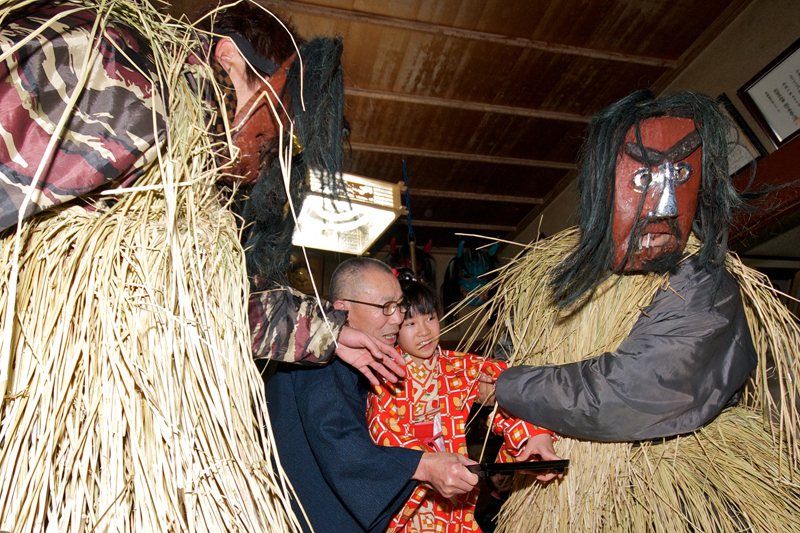
<Namahage> is designated as a national important intangible folk cultural property as [ Oga's Namahage ] In addition, it was listed on the UNESCO Intangible Cultural Heritage List as one of Visiting Gods: Gods in Masks and Disguise
I spent New Year's in Oga with snow accumulating since the 15th, and finished "Oga no Kanpu" on February 1st.
On the Oga Peninsula where Masumi Sugae walked, there are 90 marker posts and information boards set up to help you take a stroll.
The path that Masumi Sugae walked on the Oga Peninsula has been maintained as the `` Masumi Sugae Path ,'' and there are marker posts at 83 locations that have some connection to the path, and detailed information boards at 8 locations. Please use it as an aid when walking around the Oga Peninsula.

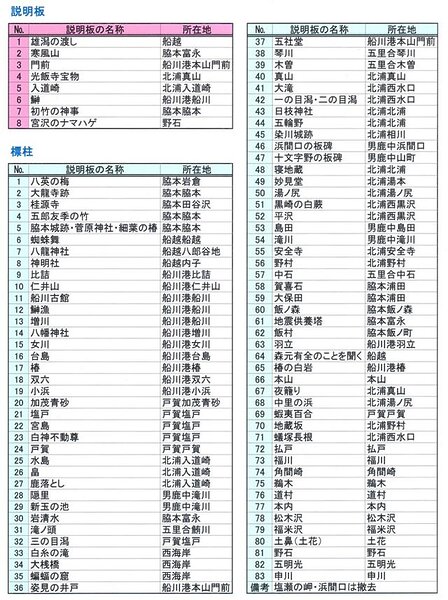








![[First] Sugae Masumi walked in Oga Peninsula - Sankaze Mountain and the Head Mountains of Faith [Akita Prefecture] 1. Group of strange rocks_Akikaze_Archives](https://jp.neft.asia/wp-content/uploads/2024/10/af533a619304de93bb8c3974f774074e-150x150.jpg)
![[Second Edition] Suga Masumi walked in Oga Peninsula - Interested in the strange rocks along the coast [Akita Prefecture] 1. Oga no Shimakaze-891-1. A copy of the Akita Prefectural Museum](https://jp.neft.asia/wp-content/uploads/2024/10/8dafd7ea0a7bd28f76a6f059db39c9de-150x150.jpg)
![[Koriyama City, Fukushima Prefecture] Space Park's planetarium is certified by Guinness! Enjoy the world's tallest space theater starry sky and children](https://jp.neft.asia/wp-content/uploads/2018/03/dffa2e7b1a9ce8ec5e557f31f5957d83_s-150x150.jpg)
![[Akita Prefecture, Oga Peninsula] Strange rocks on the west coast where ancient legends are passed down Rocky landscape of the west coast of Oga Peninsula ©Oganavi](https://jp.neft.asia/wp-content/uploads/2024/04/8764aeda3bb4db1829041fa671d1b72d-150x150.jpg)
![Akita Cedar, which has been close to people's lives since ancient times, is a close look at the reasons and secrets [Akita Prefecture] Ninfu Mizusawa Cedar Rare Population Protection Forest (Noshiro City, Akita Prefecture)_Travel Tohoku](https://jp.neft.asia/wp-content/uploads/2025/05/792bcbe7d9fd514753f4deeaca3de33f-150x150.jpg)
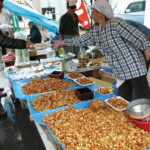

![Let's go see the natural Akita cedars [2] A forest of natural Akita cedars with giant trees over 200 years old Mt. Nanaza](https://jp.neft.asia/wp-content/uploads/2025/08/2e1cab44ce484b377d4a0b2675da2274-150x150.jpg)
